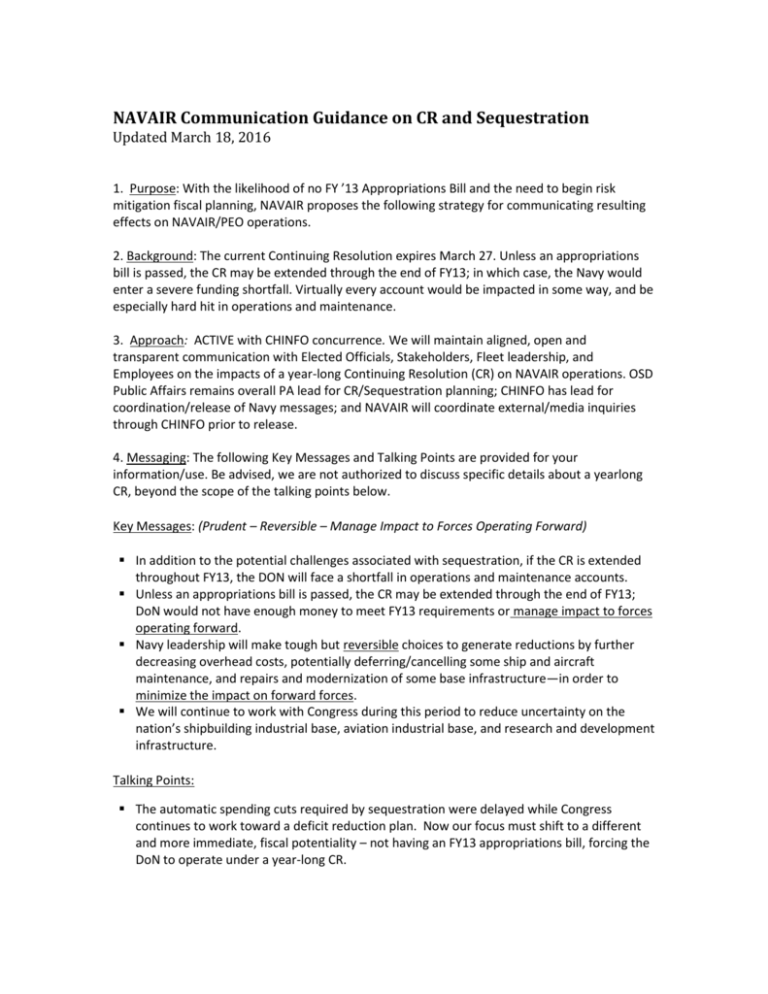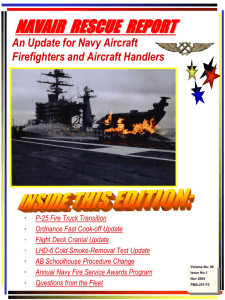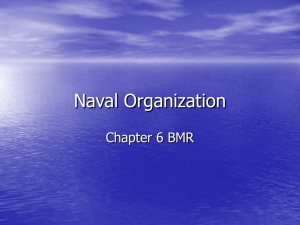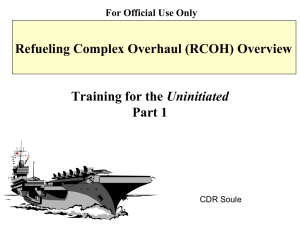NAVAIR Communication Guidance on CR and Sequestration
advertisement

NAVAIR Communication Guidance on CR and Sequestration Updated March 18, 2016 1. Purpose: With the likelihood of no FY ’13 Appropriations Bill and the need to begin risk mitigation fiscal planning, NAVAIR proposes the following strategy for communicating resulting effects on NAVAIR/PEO operations. 2. Background: The current Continuing Resolution expires March 27. Unless an appropriations bill is passed, the CR may be extended through the end of FY13; in which case, the Navy would enter a severe funding shortfall. Virtually every account would be impacted in some way, and be especially hard hit in operations and maintenance. 3. Approach: ACTIVE with CHINFO concurrence. We will maintain aligned, open and transparent communication with Elected Officials, Stakeholders, Fleet leadership, and Employees on the impacts of a year-long Continuing Resolution (CR) on NAVAIR operations. OSD Public Affairs remains overall PA lead for CR/Sequestration planning; CHINFO has lead for coordination/release of Navy messages; and NAVAIR will coordinate external/media inquiries through CHINFO prior to release. 4. Messaging: The following Key Messages and Talking Points are provided for your information/use. Be advised, we are not authorized to discuss specific details about a yearlong CR, beyond the scope of the talking points below. Key Messages: (Prudent – Reversible – Manage Impact to Forces Operating Forward) In addition to the potential challenges associated with sequestration, if the CR is extended throughout FY13, the DON will face a shortfall in operations and maintenance accounts. Unless an appropriations bill is passed, the CR may be extended through the end of FY13; DoN would not have enough money to meet FY13 requirements or manage impact to forces operating forward. Navy leadership will make tough but reversible choices to generate reductions by further decreasing overhead costs, potentially deferring/cancelling some ship and aircraft maintenance, and repairs and modernization of some base infrastructure—in order to minimize the impact on forward forces. We will continue to work with Congress during this period to reduce uncertainty on the nation’s shipbuilding industrial base, aviation industrial base, and research and development infrastructure. Talking Points: The automatic spending cuts required by sequestration were delayed while Congress continues to work toward a deficit reduction plan. Now our focus must shift to a different and more immediate, fiscal potentiality – not having an FY13 appropriations bill, forcing the DoN to operate under a year-long CR. Because most operating funding was planned to rise from FY12 to FY13, but is instead being held at FY12 levels under the CR, funds will run short at current rates of expenditure. Navy expects to receive FY13 OCO funding; however, those funds are earmarked for support of critical warfighting requirements and would not provide any significant relief to our baseline operating accounts. We project a shortfall of more than $4 billion in our base O&M accounts which funds Navy and Marine Corps readiness. Given the uncertainty, we must enact prudent, but stringent belt-tightening measures to operate the Navy and Marine Corps through the rest of the FY if the CR is extended. Each of these steps are designed to be reversible should congress pass an FY13 budget. NAVAIR/PEO/Command leaders are working closely to identify impacts and develop a consistent implementation approach. In order to slow the “burnrate” of expenditures, to be able to live within funding shortfalls created by a year-long CR, NAVAIR will take the following actions: These actions would be reversible should Congress pass a FY13 budget. - Immediate Hiring Freeze. NAVAIR leadership will be identifying any “mission essential exceptions” to this freeze, and submitting to higher Navy for approval. Decisions will be made in close collaboration with customer/programs to minimize schedule impacts. - Postpone or limit participation at government-sponsored conferences - Curtail administrative contracting support services - - Reduce travel. All non-mission essential travel and training should be minimized to the greatest degree possible. From now until 1 April, the first Flag/SES in the chain of command will determine whether travel is mission essential travel, based on the following "mission essential" categories. In these cases, only the absolute minimal number of attendees required to accomplish objectives should travel. Reduce information technology and administrative budgets - Temporary and term employees (including seasonal employees) will be released upon completion of their terms. Requests for extensions must be approved by ASN(MR&A) with AIR-00 concurrence. - Overtime: Each NAVAIR Command (NAWCAD, WD, FRC) will implement an approval process for overtime. Overtime authorization will be very targeted and limited to critical path customer needs. Furloughs: (OSD Public Affairs is the PA lead for Furlough Comms) With a yearlong CR, the potential for civilian furloughs exists (military personnel are excluded). The nature and timing of civilian unpaid furloughs is still being worked out; and we await guidance from OSD. - NAVAIR leaders are currently assessing the issues/impacts; but we will not start detailed planning until DoD sends notification to Congress and directs us to implement. - - - - Deputy Secretary of Defense Ash Carter has stated that the likely scenario is that our civilians will be furloughed one day per week (8 hours) for the last 22 weeks of the fiscal year (late April through September) One day per week (eight hours) equals a 20 percent reduction in pay for each individual DoD civilian worker. Our workforce and Congress will be concurrently notified of furlough plans around mid-February. The planned DoD FY13 civilian furlough is estimated to save $5 billion. Our 800,000 defense civilians perform critical functions like maintenance, intelligence, logistics, contracting, and health care. We are greatly concerned that furloughs will substantially harm our ability to reset and restore the force's fullspectrum combat capability after over a decade of hard fighting in Iraq and Afghanistan Enacting civilian unpaid furloughs will be a measure of last resort. But we cannot spend money that we do not have if an additional $45 billion in cuts are made due to sequestration on Mar. 2, 2013. The Navy/NAVAIR does not furlough contractor personnel. Any changes to contractor work schedules will be made by company management and negotiated via existing contract vehicles. Continuing Resolution and Sequestration Narrative and Communication Points for Navy Leaders Source: CHINFO Release Date: 7 Feb 2013 http://www.navy.mil/submit/display.asp?story_id=71937 With the budgetary uncertainty associated with the ongoing continuing resolution and the looming threat of sequestration, the Navy must begin seriously considering options to deal with what could be a $4-$9 billion shortfall in operating and maintenance accounts. The Navy Office of Information released the following communication points: "Like many Americans, you and your families are undoubtedly experiencing anxiety as a result of the fiscal uncertainty that exists in the country today. I am sure that you have seen the news recently about the many decisions the Navy has had to make to adjust to significant shortfalls in our accounts. Allow me a few moments to try to put some of that into context for you and to explain what we are doing to prepare for the consequences of having to operate without a spending bill this year, as well as the looming threat of sequestration. Let me first address the spending bill. Without an appropriations bill for this year, our Navy is funded under a continuing resolution (CR) that Congress passed back in October. It's set to expire in late March, but it could go much longer. We are planning for the potential that it could last the rest of the fiscal year. Living under a long-term CR is a big problem for us. First, it's based on last year's spending levels that do not fully cover the programs and priorities we submitted to Congress this year. Specifically, the CR underfunds our operation and maintenance accounts (OMN) by $3.2 billion. Second, we have experienced $1.4 billion of growth since last year's budget was enacted: unplanned but abnormal expenses for increased naval operations in the Middle East, increased fuel costs, as well as unexpected repairs to USS Miami (SSN 755), USS Porter (DDG 78), USS Montpelier (SSN 765), USS San Jacinto (CG 56), and USS Nimitz (CVN 68). And third, the CR limits our flexibility to react because it does not allow us to transfer funds to OMN from other accounts, such as procurement and research, to cover these shortfalls. In total, our OMN account will come up $4.6 billion short under a yearlong CR. This will impact funds for fuel, parts, ship and aircraft repairs, base operations, salaries for our government employees and contractors, and maintenance for buildings, roads and runways. If we don't start slowing the "burn rate" of those dollars now, we will not have enough funds to operate the Navy through the end of the year. So, with a focus on preserving first and foremost the readiness of our forward-deployed forces, we are: Preparing to cancel all surface ship maintenance availabilities scheduled at private shipyards from April to September. This will affect 30 of our 187 surface ships. These maintenance periods cannot be replaced once cancelled, causing the condition of these ships to degrade. Preparing to cancel all aircraft depot maintenance from April to September, affecting up to 327 aircraft and rendering them unavailable for use. Cutting spending by about half on base operating support. We may even cancel repair and modernization of nearly all piers, runways, buildings and other facilities through September 2013. Freezing the hiring of civilians and terminating temporary employees not supporting OEF mission-critical capabilities. This will reduce our shipyard workforce by more than 3,000 almost 10 percent of the workforce. Reducing overhead costs by cutting IT support, cancelling conferences, and severely limiting travel. We're even going to cut 30 facilities demolition programs, which would have provided another $62 million in contracted support and labor. IMPACTS: As you may have heard, we even asked the Defense Department for permission to remain at the current carrier presence level (only one) in the Central Command region. In other words, we will not be trying to maintain more than one carrier there at any given time. This allowed us to delay the departure of the USS Harry S. Truman (CVN 75) and the cruiser USS Gettysburg (CG 64). None of these decisions were easy to make, but I'm sure you can understand why leadership needed to make them. We simply must find a way to live within our spending limits if we want to have enough money to make it through the year, given the heavy demand overseas for naval forces. Again, the focus is squarely on preserving the readiness of our forward-deployed forces. We will continue these measures - and we may have to execute others, like reducing underway training for ships and aircraft not deployed - until a spending bill is passed or we receive authority to move money to the OMN account. It's the prudent thing to do, but we know it comes at a cost. These cuts will affect our long-term readiness, as well as the economies of the communities that help support and maintain our naval forces. The Secretary and the CNO have been very public about the specific costs to local communities and shipyards all over the country, and my expectation is that they will continue to make people aware of the very real implications to our Navy and to the people who support us. Now, if sequestration happens, it's a whole different ballgame. We would then face an additional $4 billion-$5 billion cut for this year alone, further reducing training and readiness. And because sequestration would be triggered in March - nearly half-way through the fiscal year - the Navy must absorb the additional cut in only a few months, requiring even more severe reductions to the operating account. We've only recently been given permission to plan for sequestration, but our early forecasts show that it would be virtually impossible for us to deploy follow-on forces on anything resembling a predictable schedule. Without permission to move money from other accounts to OMN, we would be forced to: Stop all deployments to the Caribbean and South America, thereby cancelling all regional exercises. Limit European deployments to only those supporting ballistic missile defense missions. Cut the number of ships and aircraft deployed to the Pacific by half ... and cut by 25 percent days at sea and flying hours for all Pacific forces. Stop stateside training and other operations for ships and aircraft preparing to deploy. What does this mean from a practical perspective? It means our aviators, their aircrews, our surface Sailors and submariners will not be properly qualified in advanced warfare techniques. Training essentially stops. We anticipate that the delay to Harry S. Truman's deployment and the reduced presence in the Gulf may buy back some of the training that would have otherwise been lost, but we don't know exactly what that is yet. For those units that do have to cease training, it also means that, once training could resume, it would take us up to 12 months to deploy naval forces again. In short, it means most of the fleet will not be ready to go anywhere by 2014. As I said, one way to avoid this level of unpreparedness is to get Congressional approval to move unspent money from other accounts. But even that provides only temporary relief. If we move money from investment accounts - like ship and aircraft construction - into OMN, we will be forced to buy fewer ships, aircraft and weapons. That will likely have a dramatic affect on things like LCS and the Joint Strike Fighter. And breaking or renegotiating existing contracts will undoubtedly cause layoffs and severely injure an already fragile industrial base. Either choice - dramatically reducing OMN spending or moving unspent investment account money - results only in a short-term gain and mortgages our future. And we might as well forget any sort of certainty when trying to plan for either the FY-14 or FY15 budgets. There will simply be no reliable basis upon which to plan, no certitude of funding upon which to allocate resources. The threat of an extended period of CR, plus the cuts required by sequestration, would fundamentally alter the Navy's ability to fight, train, and maintain our ships, aircraft, and other critical equipment. It makes us less able, if not incapable, in the near-term of doing that which the nation expects of us. And in the long run, this "perfect storm" may affect our ability to retain the very talent we will need to function in an increasingly austere fiscal environment. One thing is certain, however. Military pay and benefits will remain intact. You may have seen a recent decision by Secretary Panetta to limit your pay raise next year at one percent, but it is still a pay raise. And we have been getting pay raises each year for more than 10 years. And even with all this budget churn, that is the only impact to your compensation package. For our civilian employees, I will tell you that, yes, the Department of Defense is considering furloughs. But there have been no final decisions in that regard, and the Navy will follow whatever guidance it receives. Early indications are that, should they be approved, furloughs would take affect between April and October and result in a 20 percent cut in your pay. Again, we know this uncertainty is difficult. But we are committed to keeping you informed and to trying to preserve your readiness as much as possible. We will do our best to ensure that you are updated regularly with the latest information and forecasted impacts. Thank you. ### Cancellation of USS LINCOLN RCOH Source: CHINFO Briefing Card The USS Abraham Lincoln (CVN72) refueling complex overhaul (RCOH) will be postponed due to a lack of funding. Lincoln was expected to move to Newport News shipyard next week. The contract for the RCOH has not been issued to Huntington Ingalls Industries, Inc. Lincoln will remain at Naval Station Norfolk until either an FY13 budget with RCOH funding is approved or a yearlong CR anomaly addresses cost differences. The Lincoln will remain pierside at its homeport while ship's Sailors continue to conduct maintenance. In the 50 year life span of a nuclear aircraft carrier, typically the ship undergoes one RCOH at the mid-life stage - where complex maintenance/refueling are done to the carrier and its reactor plants. The impact of postponing CVN 72's RCOH is three-fold: the time scheduled for the RCOH will have to be lengthened because the ship isn't going to start when it was expected; delays redelivery to the fleet; and impacts industry (takes away money/jobs and can delay subsequent scheduled availabilities). Additionally, a delay in Lincoln's RCOH will affect other carrier maintenance. Because of the short time available between sequential dockings, we would also incur day-for-day impacts to the recently inactivated Enterprise (CVN 65) defueling and the start of USS George Washington's (CVN 73) RCOH. Cancelling and deferring maintenance creates a significant backlog of deferred maintenance and affects future year schedules and cost, as well as future readiness. The fiscal uncertainty created by not having an appropriations bill -- and the measures we are forced to take as a result, place significant stress on an already strained force and undermines the stability of a fragile industrial base Delayed Deployment of USS Harry S. Truman U.S. Carrier Strike Group Presence in the CENTCOM Area of Responsibility Statement from Pentagon Press Secretary George Little "The Secretary of Defense has delayed the deployment of the USS Harry S. Truman (CVN-75) and the USS Gettysburg (CG-64), which were scheduled to depart Norfolk, Virginia later this week for the U.S. Central Command (CENTCOM) Area of Responsibility. Facing budget uncertainty -- including a Continuing Resolution and the looming potential for across-the-board sequestration cuts -- the U.S. Navy made this request to the Secretary and he approved. This prudent decision enables the U.S. Navy to maintain these ships to deploy on short notice in the event they are needed to respond to national security contingencies. The United States will continue to maintain a robust military presence in the CENTCOM region, including the current carrier presence and a mix of other assets, to fulfill enduring commitments to our partners. The U.S. military continues to stand ready to respond to any contingency and to confront any threat in the region."







